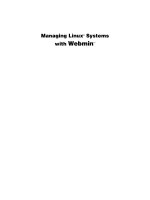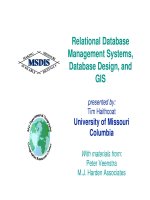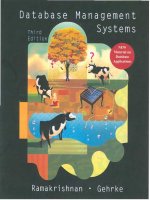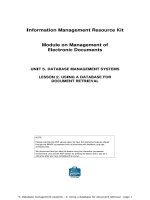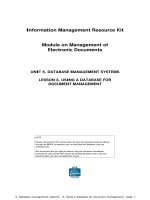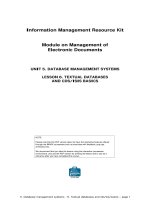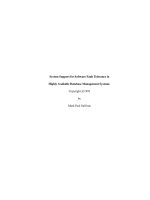UNIT 5. DATABASE MANAGEMENT SYSTEMS LESSON 4. TEXTUAL, RELATIONAL AND XML DATABASESNOTE docx
Bạn đang xem bản rút gọn của tài liệu. Xem và tải ngay bản đầy đủ của tài liệu tại đây (473.94 KB, 17 trang )
5. Database management systems - 4. Textual, relational and xml databases – page 1
Information Management Resource Kit
Module on Management of
Electronic Documents
UNIT 5. DATABASE MANAGEMENT SYSTEMS
LESSON 4. TEXTUAL, RELATIONAL
AND XML DATABASES
© FAO, 2003
NOTE
Please note that this PDF version does not have the interactive features offered
through the IMARK courseware such as exercises with feedback, pop-ups,
animations etc.
We recommend that you take the lesson using the interactive courseware
environment, and use the PDF version for printing the lesson and to use as a
reference after you have completed the course.
5. Database management systems - 4. Textual, relational and xml databases – page 2
Objectives
At the end of this lesson, you will able to:
• understand the differences between relational
and textual databases, and
• understand how XML can be used in a database
system.
Introduction
Once you have defined your
requirements for document
management and delivery, you have to
choose the type of database that can
meet your needs.
To make the right choice, it is useful to
understand the basic principles and
benefits provided by the two main types
of databases: textual and relational.
Textual or relational database: which
choice will better meet our needs?
5. Database management systems - 4. Textual, relational and xml databases – page 3
Flat file databases
If you use a comma as the separator, this is called a CSV file (Comma Separated Values).
XML in Practice,Chuck Law,30/01/99,Panda Press,345
Relational Databases,Ed Trout,14/03/85,Bross and Smart,267
Object Oriented Technology,Eva Good,27/02/95,Panda Press,456
XML in Practice,Chuck Law,30/01/99,Panda Press,345
Relational Databases,Ed Trout,14/03/85,Bross and Smart,267
Object Oriented Technology,Eva Good,27/02/95,Panda Press,456
The flat file database can be considered the first basic type of database.
A flat file database is a textual file that can be created using a simple text editor.
Each information field (e.g. title, author, publisher, etc.) is separated from others using a delimiter
character (usually a comma) and each record is separated from others using another character or
by pressing the ENTER key.
Flat file databases
You can also easily create a CSV file using a
spreadsheet. In fact, most spreadsheet packages
and some relational database products give you
the option to ‘Save As .csv’.
In this example we used Microsoft Excel.
It is very easy to write your own code to read,
write, delete and update records in a flat file
database, or you can use open source code written
by other people; one of the most widespread flat
file databases is called DBM.
Instead of using flat files with field separators and
tools such as DBM, we could use XML to
represent the fields in our database and use open
source XML parsers and processors to access
them.
More information about DBM
DBM has open source implementations available
in many languages.
Most Unix and Linux operating systems ship with
a set of DBM tools.
You can get an implementation called GDBM
from the Gnu Project (www.gnu.org
) or a Perl
implementation called SDBM from www.perl.org
.
5. Database management systems - 4. Textual, relational and xml databases – page 4
Flat file databases
A field must contain more than one item
of information. This means that all fields
are not homogeneous (e.g. the content in
the field “author” can be a single author or a
list of authors).
The same information is repeated in the
database. This means we have redundant
data storage and this can cause problems
with consistency when we want make
changes to data: apart from the additional
effort involved, there would be a risk that we
might miss out one of the changes and
make our data inaccurate.
Flat file databases work fine for simple data structures, but problems start for example when…
Mmmh…this book
was written by
three authors: I
have to store the
three of them in the
same field…
Ouch! The publisher
Panda Press was
taken over by Bross
and Smart: I have
to change its name
in all the fields!
Flat file databases
some fields contain more information than others.
some information is redundant.
XML in Practice,Chuck Law,30/01/99,Panda Press,345
Relational Databases,Ed Trout,14/03/85,Bross and Smart,267
Object Oriented Technology,Eva Good,27/02/95,Panda Press,456
XML in Practice,Chuck Law,30/01/99,Panda Press,345
Relational Databases,Ed Trout,14/03/85,Bross and Smart,267
Object Oriented Technology,Eva Good,27/02/95,Panda Press,456
For example, in
this database…
Please click on the answer of your choice
5. Database management systems - 4. Textual, relational and xml databases – page 5
Relational databases
With a relational database these problems
are solved.
A relational database is a database which
uses the relational data model for
storing data.
The basic idea is simple: instead of creating a
single logical unit which contains the entire
database, the database is split into several
tables.
Each table contains a set of records with
logically structured data.
Relationships between the data in different
records are used to join the tables together
to form a single logical database.
Let’s look at an example
Relational databases
To store bibliographic information in our library we could create a Bibliography table with five
columns (fields): title, author, publication date, publisher, number of pages.
Each row corresponds to a specific book (record). Here’s what the table looks like when we
create it in Microsoft SQL Server and load up three records:
TITLE
NUMBER OF PAGES
AUTHOR
PUBLISHER
The fields in the ‘publication date’ column are all of type ‘Date’ and the fields in the ‘number of
pages’ column are all integers.
The other fields could be transformed into as many separate tables. Let’s see how…
PUB.
DATE
5. Database management systems - 4. Textual, relational and xml databases – page 6
Relational databases
For example, we can make a separate
table called ‘Publishers’ that contains
the names of all the publishers and then
refer to records in that table from
fields in the bibliography.
In that way we only have one record
for Panda Press, which is used by
reference everywhere else that we need
it.
PUBLISHER
Panda Press
Bross and Smart
1
2
3
…
…
…
n
……………………
……………………
……………………
……………………
……………………
Relational databases
To make the reference without ambiguity
you need to be able to uniquely identify
each record in the Publishers table.
To do that we define a primary key in
the Publishers table: this is a one or more
columns which uniquely identify a record
in the table.
Sometimes it is necessary to create a
column with an id value: for example,
pubId.
5. Database management systems - 4. Textual, relational and xml databases – page 7
Relational databases
In the Bibliography table the
publisher is now something
called a foreign key: it takes
the value of a primary key in
another table and is used to
make reference to records in
that other table.
To indicate this change we
will change the name of the
publisher column to
publisherKey.
Now we can change our Bibliography table so that each record has a primary key and the
‘publisher’ column no longer holds the name of the publisher, but the pubId of a publisher in the
new Publishers table.
Relational databases
If we want to get the
relationship back directly in a
single record we need to join
the two tables back together
again (using a query expressed
in the relational database query
language SQL).
Note. Access SQL is used in this
example. It would not
necessarily work on other
databases.
Now we are sure that there is no data redundancy, but we don’t have the direct relationship
between a book and its publisher expressed in the record in a single table; it is encapsulated
in the reference between the two tables.
5. Database management systems - 4. Textual, relational and xml databases – page 8
Relational databases
One of the benefits of the relational data
model is that it allows you to create a
normalized data model, where no data
are repeated.
What we have created is a one-to-many
relationship between a publisher and
books, that is to say one publisher may
publish many books.
We could do the same with authors.
So far our bibliography has a single
author for each publication, but what if
we now want to allow publications with
more than one author?
Panda Press was taken over by Bross and
Smart: no problem, I can update the
database without changing every
occurrence in the bibliography table!
Relational databases
So far, the only way we can allow a book
to have more than one author, using the
Bibliography and Authors tables that we
have, is to repeat rows for each
publication with a different author in
each row.
So here we have repeated the row for
‘Object Oriented Technology’ so that it can
reference both Eva Good and Chuck Law
as authors.
Once again we have a redundancy
problem!
We want to allow any author to write many books and any book to be written by many authors.
This is called a many-to-many relationship between authors and books.
5. Database management systems - 4. Textual, relational and xml databases – page 9
Relational databases
We call this table
AuthoredWorks: it will hold
foreign keys to records in the
Bibliography and Authors tables.
We can now get a list of
publication titles and their authors
by executing an SQL query that
joins the Bibliography and Authors
tables as shown in the figure.
In fact, although we are only talking about two entities (e.g. authors and books) we can’t model the
many-to-many relationship between them properly in a relational database unless we introduce a
third table.
Note. Access SQL is used in this
example. It would not
necessarily work on other
databases.
Relational databases
Relational databases are often used as the basis for document or content management
systems, which provide several benefits for the management and delivery of information.
On the other hand, you do not always need all these features; it depends on your requirements.
Document management
features
Access and retrieval features
-Import/Export
- Check in/Check out
- Access control
- Version control
- Variant management
- Workflow (process management)
- Back up/Restore/Logging
- Metadata management
- Support for cross references and
link management
- Integration with editing and
processing tools
- Document configuration
- Full text index and search
- Metadata index and search
- XML (or HTML) structural search
- Paging or search results
- Sorting/filtering or search results
- Format transformation
- User profiling and preferences
-Customisedviews and
configurations by user or role
Features of Document Management systems
5. Database management systems - 4. Textual, relational and xml databases – page 10
Textual databases
Let’s have a look at this example.
We have to choose a database for a
simple bibliographic reference
database.
The main requirements for our system
are:
•quick search of the full text of the
documents,
• metadata search,
• controlled update of the document
collection (infrequently), and
• browsing of the document collection,
based on metadata.
We need a database which links to
the full text of each document
stored.
Textual databases
In our example, which are the main features needed in the database?
Integration with editing and processing tools.
Metadata index and search.
Full text index and search.
Version control.
Please click on the answers of your choice
5. Database management systems - 4. Textual, relational and xml databases – page 11
Textual databases
To satisfy our need we can use a
textual database.
If we already had a relational database
installed and some programming
resources available, then it would be
possible to implement a system to meet
our requirements.
We could also meet the requirements
using a document management system
based on a relational database,
although the system would include
many features that we don’t require in
this instance.
<?xml version="1.0" encoding="UTF-8"?>
<rdf:RDF
xmlns:rdf=" />syntax-ns#"
xmlns:dc=" /><rdf:Description>
<dc:creator>Chuck Law</dc:creator>
<dc:publisher>Panda Press</dc:publisher>
<dc:description>A basic introduction to XML with
hands-on exercises</dc:description>
<dc:identifier>ISBN-129-12992</dc:identifier>
<dc:format>PDF</dc:format>
<dc:title>XML in Practice</dc:title>
<dc:date>30/01/99</dc:date>
<dc:language>EN</dc:language>
</rdf:Description>
</rdf:RDF>
The type of metadata we want to hold for each document is shown in this XML fragment, which
uses the metadata standard called RDF:
Textual databases
Textual Databases (often called Textbases) store
collections of documents or texts as a series of
records and fields. The data structures in a
textbase are fixed and hold the text, metadata and
indexes.
Textual databases are designed to manage text-
based resources, providing users with fast search
and retrieval and some control over the assembly
and formatting of text components.
The defining features of a textual database are:
• Management of text as discrete records
• Indexing of text in the records
•Fast search and retrieval functionality
• Sorting and assembly of document records
• Packaging, transformation or formatting of
text documents
5. Database management systems - 4. Textual, relational and xml databases – page 12
Textual databases
The structures supported by
text databases are limited (to
these simple linear collections)
and are generally fixed in the
database.
Textual databases may also
provide text management
tools.
MFN
Author(s)
Title …
Record 1 1
Salih, A.G.
…
Record 2 2 …
…… …
FIELD
(Author)
FIELD
(Title)
Most textual databases break a collection of documents down into a sequence of records (some
also allow a sub-division of records into fields).
Textual databases may also provide text management tools that include:
• Hyperlink management
• Document assemble (putting together compound documents from a set of smaller components)
• Document comparison
• Hyperlink verification
• Support for multiple languages
• Metadata search
• Thesaurus search and integration
• Annotation (so that individual users can associate their own notes with text records or fields)
Textual databases
The most powerful features of text bases are
centered around their ability to rapidly search
large document collections and retrieve
records which are then displayed to the user (if
necessary with some formatting added).
Commercial textbase products have included
BASISplus, BRS/SEARCH and Folio VIEWS.
CDS/ISIS is a text database maintained by the
UNESCO General Information Programme.
In recent years relational databases such as
Oracle and SQL Server have added the
capability of full text index and search and
this, combined with the emergence of XML as a
standard for structured text, has led to something
of a decline of more specialist textbase products.
5. Database management systems - 4. Textual, relational and xml databases – page 13
XML and databases
Relational databases can be used as
XML database, but the relational
model of tables is not naturally suited
to modelling the hierarchical structures
of XML documents.
So one or more layers of
transformation between the XML data
structures and the structures stored
persistently on disk are needed.
With the rise in adoption of XML, the
leading relational database vendors
have moved to add XML support into
their products.
table
te
xt
te
xt
te
xt
te
xt
te
xt
te
xt
te
xt
te
xt
Relational database
Recently there has been much technical work on the linkage of XML and databases.
XML structure
XML and databases
During the late 1980s and early 1990s this problem was addressed by
a new breed of products: object-oriented databases.
Because the model used by object-oriented databases is very similar to
the hierarchical model of XML documents, these databases have often
been used to implement XML databases.
It turns out that the object caching mechanisms of some object-
oriented databases don’t work very well with XML structures
(particularly when fine-grained reuse of XML elements is implemented).
So by the time XML became firmly established as a technology, the
race was on to develop a new generation of native XML databases,
which lay down XML structures directly to persistent disk storage.
object
Object Oriented
database
Native XML database
More information about native XML databases
Some commercial products include Tamino (www.softwareag.com), X-
Hive (www.x-hive.com) and TextML (www.ixiasoft.com). There are
also some good open source implementations, most notably Exist
(exist.sourceforge.net).
The native XML data type added by Oracle at Oracle9i also turns that
database into the equivalent of a native XML database. With XML
support in all the leading relational database products there is a danger
that the specialist native XML databases vendors will suffer the same
fate as the object-oriented vendors of the 1990s. This is a factor that
should be considered when buying products.
5. Database management systems - 4. Textual, relational and xml databases – page 14
Summary
•The flat file database is the first basic type of database; it can be a
textual file created using a simple text editor.
•A relational database is a database which uses the relational data
model for storing structured data.
• Relational databases support a normalized data model, where there is
no redundant information storage.
• If you only need to manage text-based resources, providing users
with fast search and retrieval and some control over the assembly and
formatting of text components, you can use a textual database.
• Different types of XML databases can be implemented using relational,
object-oriented or native XML databases.
Exercises
The following five exercises will allow you to test your understanding of the concepts described up to
now.
Good luck!
5. Database management systems - 4. Textual, relational and xml databases – page 15
Exercise 1
Which of the following files is a flat file database?
Please click on the answer of your choice
A simple text file which doesn’t contain record and fields.
An XML file which represents records and fields.
A simple text file using field and record separators.
Exercise 2
Which is the
primary key in
this table?
Please click on the answer of your choice
bibId
publication_date
publisherKey
5. Database management systems - 4. Textual, relational and xml databases – page 16
Exercise 3
In your opinion, the main requirements are for…
Imagine that you need to manage the documentation at each phase of a project
(design, development and implementation), with particular requirements to:
• make documents available in read-only mode to all project participants;
• allow document owners to create and update documents;
• manage the versions of all documents;
• link documents with project-related information and metadata.
indexing documents and provide an indexed search to help
users find them.
managing the production and access to documents.
Please click on the answer of your choice
Exercise 4
Your main requirements are managing the production and access to documents.
You also need to manage versions very carefully, since it is likely that there will be
very frequent updates to the documents.
Which of the following types of database can meet your needs?
A relational database.
A textual database.
Please click on the answer of your choice
5. Database management systems - 4. Textual, relational and xml databases – page 17
Exercise 5
Could you associate each type of database with the relevant feature?
Native XML database
Relational database
Object-oriented database
It uses a very similar model to that
of XML documents
It needs an XML support to manage
XML documents.
It is ideal to implement fine-grained
reuse of XML elements.
Click on each option and drag it to the
correspondent box.
If you want to know more
DBM Flat File database. You can get an implementation called GDBM from the Gnu Project
(www.gnu.org) or a Perl implementation called SDBM from www.perl.org.
Date, C.J. An Introduction to Database Systems, UK, Addison Wesley; ISBN: 0201787229.
www.B2Business.net - an online portal with information on products for electronic business,
including listings of document and content management systems.
CDS/ISIS is a text database maintained by the UNESCO General Information Programme:
/>Resource Description Framework (RDF) Model and Syntax Specification. Eds. Ora Lassila,
Ralph R. Swick.
/>www.rpbourret.com/xml/XMLDatabaseProds.htm
A list of XML Database products, maintained by independent consultant Ronald Bourret.
Tamino XML Server, a Software AG product offering for storage, maintenance, publishing and
exchange of XML documents ( />X-Hive Corporation, developing and marketing X-Hive/DB, a native XML database
( />IXIASOFT, the company which have developed TEXTML Server, an XML Content Server for
storing, indexing, and retrieving XML documents ( />SourceForge.net, a website for the development of Open Source software, including Exist, a
native XML database ( />)
